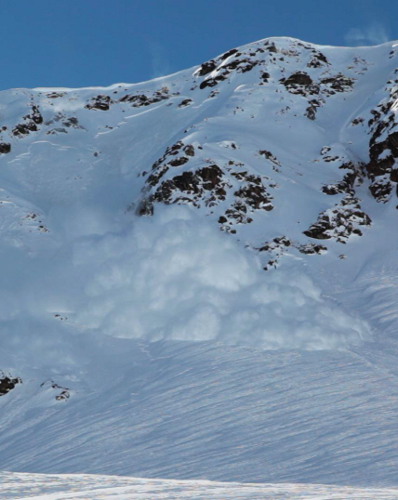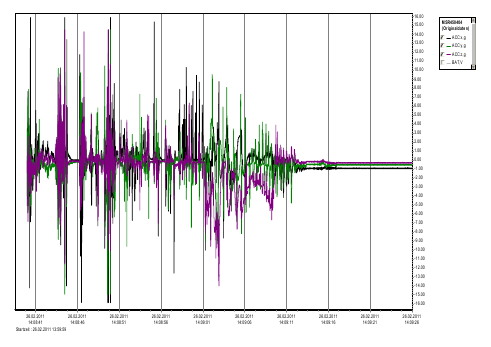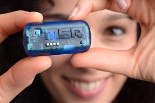MSR datalogger in use for avalanche airbag test
Can special rucksacks prevent avalanche injuries? A test carried out by the Swiss consumer magazine K-Tipp shows that these emergency systems actually work very well.
If you are caught in an avalanche and are buried underneath snow, your chances of survival are slim. This is underlined by figures from the WSL Institute for Snow and Avalanche Research (SLF) in Davos, Switzerland: If a victim’s head is buried beneath the surface of the snow half of the victims will suffocate. Over the past three years 68 people were killed in Switzerland as a result of avalanches and there have already been 13 deaths this winter. Victims have the greatest chance of survival if they are located and rescued within the first 15 minutes. The decisive factor here therefore, is that the avalanche victims are located as quickly as possible. It is also important that they are not buried too deeply in the snow. The two modern avalanche emergency systems tested by K-Tipp address precisely these issues.
- The airbag system: This employs inflatable airbags. These provide victims with flotation, ensuring that they remain near the surface and are not buried so deeply. K-Tipp tested two products in this category: The ABS model, where two side airbags are inflated, and the Snowpulse, which forms a collar around the head and neck. Both models require manual actuation and they are worn in special rucksacks.
- The Avalanche Ball: According to the manufacturer’s own marketing, this is the “fastest system in the world for locating victims buried by avalanches”. This system also requires a ripcord to be pulled. This causes a spring to deploy a red ball which is connected to the victim with a rope. The ball remains on the surface of the snow, allowing the victim to be quickly located.
Test dummies remained on or near the surface of the snow
 But how good are these life-saving devices that cost up to 1,200 Swiss Francs? That’s exactly what K-Tipp wanted to find out with their comprehensive practical test (see below, “How the test was carried out”). The results indicate that both air bag models perform well. This has much to do with their good visibility, i.e. that the airbag and possibly part of the victim’s body were clearly visible when the testers searched for the dummies after throwing them into the avalanche. The airbag systems also proved to be a useful aid to survival in terms of depth of burial in the snow. None of the devices however, will always prevent a victim becoming buried by a life-threatening avalanche – even if the manufacturers may suggest otherwise.
But how good are these life-saving devices that cost up to 1,200 Swiss Francs? That’s exactly what K-Tipp wanted to find out with their comprehensive practical test (see below, “How the test was carried out”). The results indicate that both air bag models perform well. This has much to do with their good visibility, i.e. that the airbag and possibly part of the victim’s body were clearly visible when the testers searched for the dummies after throwing them into the avalanche. The airbag systems also proved to be a useful aid to survival in terms of depth of burial in the snow. None of the devices however, will always prevent a victim becoming buried by a life-threatening avalanche – even if the manufacturers may suggest otherwise.
All the same, the tests indicated that in only 6 of 14 cases was the head of the test dummy – and therefore, its nose and mouth – buried deeper than 10cm. The maximum depth of burial in the snow was 40cm in two cases. ABS spokesperson, Julia Schmideder, notes, “the test dummies are usually completely buried, because they are unable to move.” The test dummies that were not equipped with an emergency system were, in comparison, buried in up to 85 centimetres of snow. In most cases no parts of the body were visible above the snow – search and rescue would therefore have taken much longer. The Avalanche Ball only achieved a satisfactory rating. Despite being always immediately visible, the ball cannot “float” the victim to the surface, meaning that the nose and mouth were covered in a depth of between 10 and 70 centimetres of snow.
 “The Avalanche Ball was developed so that people can immediately find other people”, states Daniela Venier, Avalanche Ball spokesperson. A further result of the test is that the Snowpulse airbag could also protect against injuries to the neck. This is indicated by the measurement results from the sensors. The Snowpulse airbags do not inflate at the sides of the body, but form a collar around the head and neck. The risk of losing consciousness with the Snowpulse may be lower that with the ABS airbag or the Avalanche Ball. For this reason a quarter point was deducted from the scores of the latter.
“The Avalanche Ball was developed so that people can immediately find other people”, states Daniela Venier, Avalanche Ball spokesperson. A further result of the test is that the Snowpulse airbag could also protect against injuries to the neck. This is indicated by the measurement results from the sensors. The Snowpulse airbags do not inflate at the sides of the body, but form a collar around the head and neck. The risk of losing consciousness with the Snowpulse may be lower that with the ABS airbag or the Avalanche Ball. For this reason a quarter point was deducted from the scores of the latter.
All of these devices must be triggered manually. This is a disadvantage because victims that begin to panic after being engulfed by an avalanche, or that are unable to reach the pull handle, will lose the benefit of his emergency system. Furthermore, both systems are unable to prevent injury caused by entrained stones. They also provide no protection if the avalanche causes the victim to be pushed and dragged against a rock face. It is far more important not to expose yourself to unnecessary risks and, as far as possible, to avoid an avalanche accident in the first place.
Good preparation is therefore necessary and a proper assessment of the avalanche danger should be carried out at the location. Before embarking upon a tour the following tips should be observed:
- Inform yourself about the current weather and avalanche situation (Avalanche bulletin at www.slf.ch).
- Prepare yourself at home and continuously observe the conditions at the location, the ground conditions and the people involved. Available safety sheets: “Avalanche risk – better assess the risks”, and “Caution, avalanches!”.
- Particularly important: Switch your avalanche transceiver to transmit, do not forget your shovel and avalanche probe (standard emergency equipment).
- Never venture out alone and do not follow unknown tracks that lead into unknown country.
- Avoid the steepest slopes. Assess recent accumulations of snow critically. Take into consideration the warming that occurs over the course of the day. Negotiate areas of questionable stability and steep slopes individually.
- If you do not possess the necessary knowledge and experience join an organised group or stick to marked pistes.
- The “White Risk”, tutorial on CD is also helpful. This presents avalanche prevention information from SLF and Suva. It can be downloaded or ordered at www.whiterisk.ch. It is also available as an iPhone or Android app.
How the test was carried out
The K-Tipp test is the world’s largest independent test of avalanche emergency systems over the past ten years. It was carried out during two days at the end of February in the area of the Flüela Pass. The test was carried out in cooperation with the WSL Institute for Snow and Avalanche Research (SLF).
The test objects were man-sized dummies with moveable arms and legs and a weight of some 80 kilogrammes. Each was exposed to avalanche conditions four times (on four different slopes). The avalanches were triggered with controlled explosions carried out by the responsible rescue authorities at Davos/Klosters.
Three dummies were fitted with one of the test systems and the fourth served as a control dummy without an emergency system. The three dummies were thrown into the avalanche with the airbag or avalanche ball deployed. Once the avalanche had subsided the SLF experts assessed the visibility of the emergency system, body and head and measured the depth of burial in the snow.
The risk of injury was also assessed. Here, special MSR145 dataloggers from MSR Electronics GmbH were used to measure the accelerations in the neck area.
K-Tipp | 20th March 2011 | Darko Cetojevic, Daniel Jaggi, Christian Birmele
You may also be interested in these articles:
- People on a G-force high - How acceleration affects our bodies (TV, Sat.1)
- “Man vs. Wild”: Acceleration measurements in an adventure documentary (TV, Discovery Channel)
- MSR dataloggers for patient monitoring and health management
- The fast way to the right datalogger
- MSR145: The revolutionary mini datalogger
 Deutsch
Deutsch

